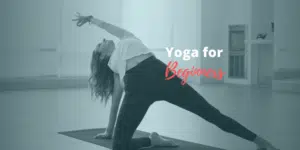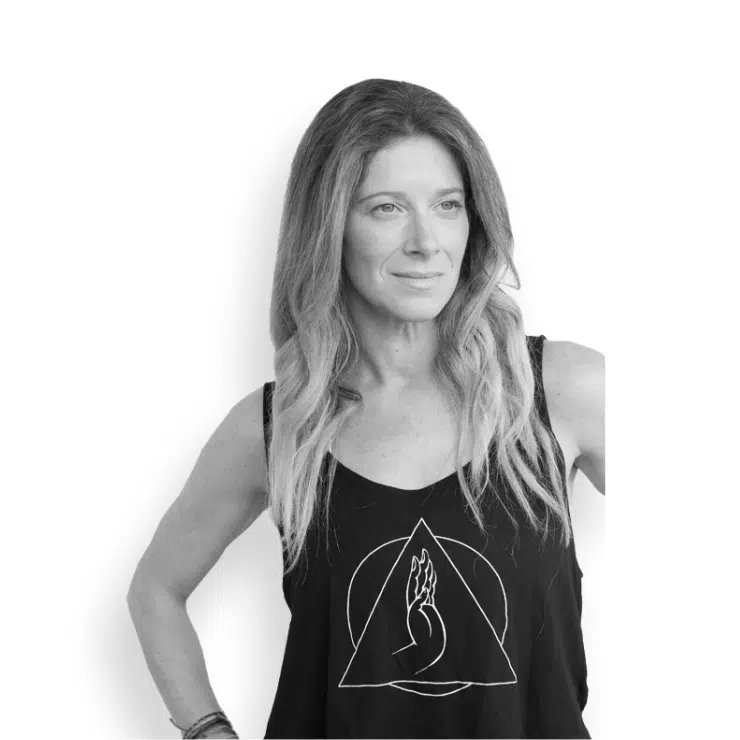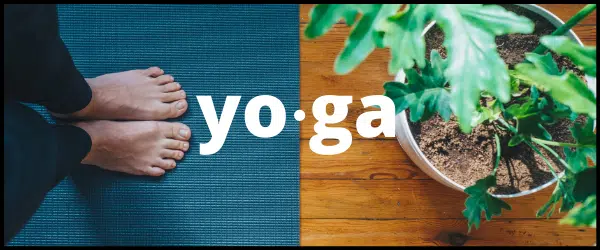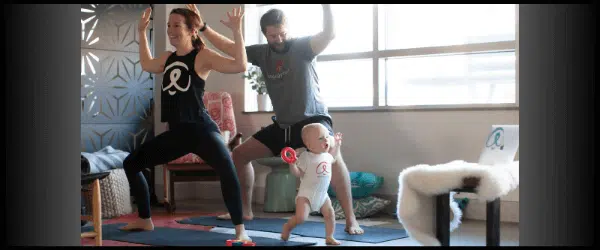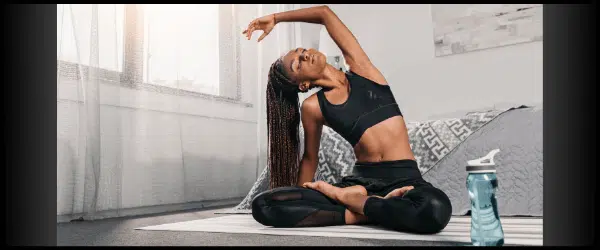Interested in yoga but not sure where to begin? Take a look at our guide to beginners yoga to help you get started.
If you’ve ever seen a photo or watched a video of people in complicated-looking yoga poses, you may have thought to yourself, “That looks way too hard. I could never do yoga.” With this kind of thinking, you’re bound to quit before you even begin — but you have to start somewhere!
In fact, there are so many variations to a yoga practice that you can absolutely start with yoga for beginners and progress from there. You can get started from wherever you are, which is why yoga really is for everyone. There’s no need to be intimidated!
This yoga for beginners guide is meant to inspire you to begin your yoga journey… right now. Check a full-length sample Beginner Yoga class to see what we’re all about!
Table of Contents:
Health Benefits of Online Yoga
How Often Should You Practice Yoga
Equipment for Beginners to Yoga
Check out our tailored workout plan:
We took the guesswork out of how to get started 😉 Try it with your FREE TRIAL!
What is yoga?
Yoga is a physical practice in which participants move through a series of poses, each of which stretches and strengthens different parts of the body. Yoga can look different from one studio or practitioner to the next, since some emphasize meditation and breathwork, while others take a more fitness-based approach.
The practice of yoga has its deepest roots in Indian culture.
According to an article by India’s National Ministry of External Affairs:
Yoga is believed to have started with the dawn of civilization. The word “yoga” comes from the Sanskrit root “Yuj,” which means “to join” or “to yoke” or “to unite,” the idea being that the practice of yoga unites mind and body. Early practitioners also believed that practicing yoga allowed individuals to connect with the larger universal consciousness.
In its early days, yoga was primarily a spiritual practice. Over time, it has developed in many different directions.
Yoga in the 21st Century
While many people still practice yoga for spiritual reasons, contemporary variations are often geared more toward exercise and fitness benefits. As a high-energy, cardio-based brand of yoga, Bulldog Yoga certainly leans that direction, though we offer a wide variety of online classes.
Per a study from the Yoga Alliance:
49% of the 37 million yoga practitioners in the U.S. in 2016 noted “general fitness” as their number-one reason for getting involved in the practice.
Yoga’s focus has clearly evolved since its early days!
Beginner Yoga at Home
Yoga for beginners classes are intended to make yoga as approachable as possible, but taking those beginner yoga classes to your home turf can make you feel that much more comfortable getting on the mat. And since there are so many classes now available online, doing beginner yoga at home is a fantastic option! And, to make things even easier, we’ve created this comprehensive library of common yoga poses and how to do them 🙂!
When you take your yoga for beginner classes at home, you can schedule your workouts based on what’s most convenient for you, instead of a studio’s limited offerings. Plus, you won’t lose time on the commute! At-home classes are especially well-suited for yoga newbies, since they give you a chance to learn the basics of the practice without worrying about what’s going on around you.
Want to find out more about trying yoga at home? Check this out!
Health Benefits of Online Yoga
Yoga has many health benefits — and beginners can take advantage of them, too! According to the National Center for Complementary and Integrative Health, research has proven that yoga can relieve stress, help people manage depression and anxiety, support weight loss efforts, help people manage symptoms of chronic disease, and more.
Let’s take a closer look at three of the health benefits of online yoga.
Improves Sleep
Getting high-quality sleep is a challenge for far too many of us. Yoga can help! A study from the National Center for Complementary and Integrative Health notes that more than 55% of yoga practitioners reported better sleep compared to before they started doing yoga.
Per Harvard Health, doing yoga poses just before bedtime can help you wind down your day so you can sleep more and sleep better. Even if you do yoga earlier in the day, it can reduce your stress so it’s easier to fall asleep later on. And since yoga has been proven to reduce pain (more on that below), you may find it easier to get comfortable in bed.
Reduces Pain
Yoga is a low-impact exercise that can be used to stretch and strengthen specific body parts. As a result, it’s often used for pain management. According to Psychology Today, practicing yoga actually has the opposite effect of pain on the brain. It helps rebuild the gray matter in the brain that is caused by chronic pain, which may be why it can offer relief.
Learn more about yoga for pain management here.
Improves Bone Health
As we age, our bones age with us and become weaker. This puts us at a greater risk for osteoporosis and injuries. But yoga can help!
A 2016 study of more than 700 yoga practitioners demonstrated that a 12-minute daily yoga regimen can reverse bone loss caused by osteoporosis. Participants experienced an increase in bone mineral density, particularly in their spines and legs. Harvard Health also notes that yoga’s other proven health benefits — improved mobility, flexibility, etc. — can prevent falls that might cause further bone damage.
Increases Focus
As mentioned earlier, yoga has a history as a spiritual practice and is still used for many mental and emotional benefits. Like meditation, it’s considered a mindfulness practice. Per Harvard Health, yoga helps you develop an inner awareness by linking the mind and body. It also forces you to stay in tune with your breath and body as you move between poses. You can take these skills off the mat in order to be more focused on other aspects of your life.
Check out this post for more about the health benefits of online yoga classes!
How Often Should You Practice Yoga?
Yoga is a low-impact form of exercise, so you can really do it as often as you’d like and as often as your body will allow it. If you’re just getting into yoga for beginners, it’s probably best to err on the side of caution, starting with just two or three sessions per week at the most. With each class, your body will get stronger. Ultimately, you’ll feel more confident to take on more classes, maybe even at a higher intensity.
At the start of your yoga journey, though, plan on taking two to three yoga for beginners classes every week. This is a good rule of thumb for new practitioners! From there, listen to your body when deciding how often to practice.
Looking for more details about how to create the ideal schedule for your yoga practice? Learn more about how often you should do yoga here.
Beginner Yoga Styles
Yoga is not a one-size-fits-all exercise. There are many different styles out there to try! There is even variation among beginner yoga classes, so you can really choose the style you’re most excited about and that’s best-suited to your wellness goals.
As far as yoga for beginners, Bulldog Yoga offers slow flow yoga, Bulldog Basics, and Activate classes. Beyond that, there are classes offered at higher intensities — including Exhilarate and Invigorate classes — along with meditation, yoga sculpt, and more.
Activate Classes
All of our low-intensity classes are captured under the Activate umbrella. Activate classes are designed to allow you to work your entire body to calm, but energetic music. They’re also great for stress relief!
Interested in learning more about beginner yoga styles? Take a look at our yoga styles for beginners handbook here!
Slow Flow Yoga
When you’re a beginner at anything, it never hurts to start slow. Yoga is no exception! In slow flow yoga classes, instructors will move through a yoga flow very slowly, giving your body plenty of time to move into each pose. Slow flow classes will also give you the chance to learn yoga lingo and the names of each pose without feeling any pressure to hurry. This can help set you up for success in future classes.
Bulldog Basics
Bulldog Basics classes are exactly what they sound like. Most of these classes are 30 minutes or shorter, and they walk you through the building blocks of a yoga practice so you’re ready to tackle other types of classes, too.
Beginner Yoga Poses
As we’ve described, a yoga practice is really a progression. You can start with yoga for beginners and move into more advanced or different styles of yoga over time. You can focus on different poses and stay away from others as your needs, fitness level, and wellness goals evolve and change.
There are a handful of basic yoga poses that you’ll likely see included in any beginner yoga class — Child’s Pose, Table Top, High Plank, Upward Dog, Downward Dog, Mountain Pose, Warrior 1, and Warrior 2, to name a few. Beginners should stay away from more complicated poses like headstands and shoulder stands. As a rule, inversions (any pose in which your heart is higher from the ground than your head) should be saved for later on in your practice. There will be time to explore them down the road!
Here are a few beginner poses you should get comfortable with early in your yoga journey:
Mountain Pose
Mountain pose serves as the foundation for many other standing poses in yoga. It’s great for your balance and posture.
Stand with your feet together and your arms at your sides. Make sure your weight is distributed evenly across your feet. Press your big toes together, separating your heels slightly. Lift and spread your toes and the balls of your feet, then set them back down. Lengthen your tailbone and imagine a straight line extending from the top of your head to the floor. Hang your arms beside your sides.
Warrior 1
Start in Mountain pose. Step your feet about four feet apart. Lift your arms perpendicular to the ground, palms down. Turn your left foot in 45 to 60 degrees to the right and your right foot out 90 degrees to the right. Your heels should be aligned. Rotate your torso to the right and keep your hips square to the front of your mat. Bend your right knee over the right ankle so your shin is perpendicular to the floor.
Turn your feet to the left and do the same on the opposite side.
Warrior 2
Again, start in Mountain pose. Step your feet about four feet apart. Lift your arms perpendicular to the ground, palms down. Turn your right foot slightly to the right and your left foot 90 degrees. Keep your heels aligned. Bend your left knee over your left ankle so your shin is perpendicular to the ground.
Turn your feet to the left and do the same on the opposite side.
Learn about other beginner yoga poses here!
Equipment for Beginners
One of the coolest things about yoga is that it doesn’t require a lot of equipment! This makes it really easy and inexpensive to get into yoga for beginners. The only thing you really need is enough space to move your arms and legs around — but there are a few items that can make yoga classes feel more comfortable and accessible.
We recommend starting simple. Having a yoga mat and a set of workout clothes you feel good in should set you up for success! From there, you can add items like blocks and straps, if you want!
Mats
Yoga mats are meant to be placed on the floor below your feet while you practice yoga. They offer a nice cushion and can help prevent you from slipping while you move between poses. You can buy low-price yoga mats at big box stores (like Target), sporting goods stores, and major online retailers.
Blocks
As you begin to experiment with different poses, you might find that certain positions are less accessible for your body than others. That’s where yoga blocks come in! They are typically made from foam and can act as a sort of arm extension so you can more easily balance in one-legged poses. They can also help support your hips, head, and back in poses that feel more challenging.
Straps for Yoga
Straps primarily come in handy for stretching, since they allow you to achieve a wider range of motion. If one of your wellness goals as you start beginner yoga classes is to become more flexible, you may want to add a yoga strap to your setup.
Reminder: Choose Proper Clothing
When it comes to choosing attire for yoga classes, the most important factor to consider is how easily you can move! Go for breathable items that allow you to maximize your range of motion without you feeling restricted. While yoga clothing doesn’t need to be skin tight, baggier items can get in the way of certain poses, so keep that in mind. Choose clothes that make you feel comfortable and confident!
Shoes and socks are not necessary for yoga, so there’s no need to worry about that.
Easy Yoga Classes for Beginners
While there are no “rules” about the classes you should take at each stage of your yoga practice, it’s obviously recommended that you start at the beginning — with beginner classes! This will give you a chance to get used to the flow of the class and gain a better understanding of the movements. Plus, you’ll be less likely to push yourself too hard and risk getting hurt. Once you’ve moved through a few beginner classes, you’ll be ready to explore more challenging levels.
Luckily, we have a wide variety of beginner classes available online, so you can experiment from the comfort of your own home.
Learn more about why you should start with easy classes in this post!
Bulldog Basics 1
This is an excellent introduction for yoga newbies! It offers 29 minutes of basic instruction, which will give you the building blocks for other beginner classes. Plus, the playlist includes artists like John Mayer, The Verve, and James Bay.
Try out the class here.
Good Morning Activate
Our slow flow yoga classes are perfect for yoga beginners, and this one will help you wake your body up at any time of the day. You’ll move and stretch slowly through a series of poses to the sounds of mellow pop tunes.
Experience this class here.
Bust the Flexibility Myth
One of the most common hesitations we hear from people who are unsure of whether or not to start practicing yoga is this: “Don’t I have to be flexible?” The short answer is that you don’t. In fact, yoga is intended to help you become more flexible over time. This four-minute class will teach you a few basic flexibility-focused poses and reassure you that you don’t have to be a human pretzel to do yoga!
Ready, Set, GO! 🚦
Take the quiz to have a custom beginner’s workout designed for you!
